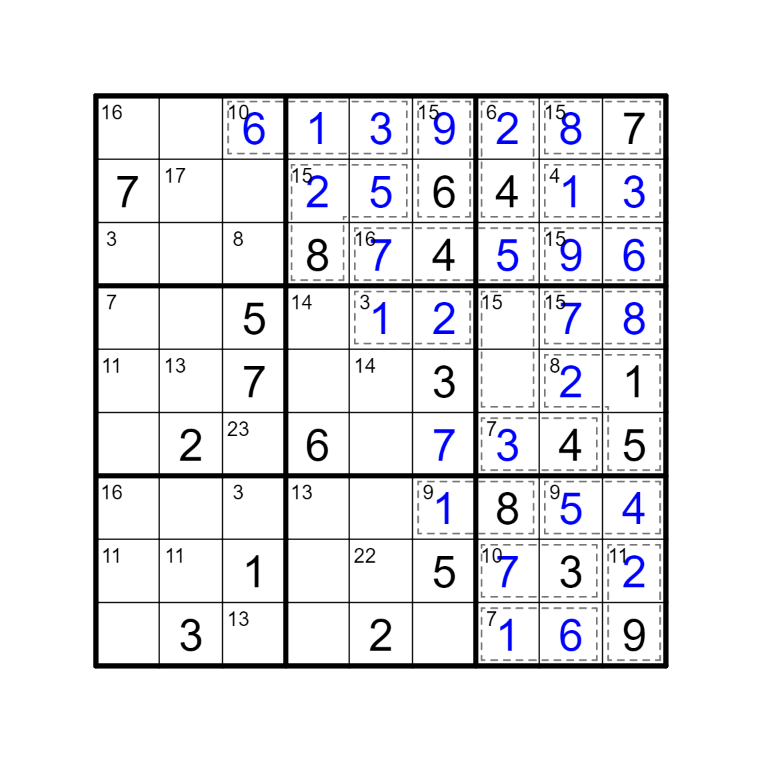First, place '7' in R3C5 due to Sudoku rules. Then, focus on the upper right 3 x 3 square. The '4' killer sum can only extend to the right and it can only be made from (1 + 3). Since there is already a '1' in C9 and a '3' in C8, we can fill 1'1' in R2C8 and 2'3' in R2C9. Then, this also forces the 15'15' killer sum just above to extend to the right (since killer sums must appear at the top left of their group). Therefore, R1C8 is 8'8'. Then, notice that the '15' killer sum in R4C8 can only extend to the right. This must mean that the '15' killer sum in R3C8 must comprise of 2 cells, and the digits must be 6'6' and 9'9'. Due to the 9'9' in C9, we know 9'9' is in R3C8 and 6'6' in R3C9. This leaves 5'5' for R3C7.
The grid at this point:
Next, we focus on the middle right 3 x 3 square. The '8' killer sum must extend to the right. Therefore, the '15' killer sum just above it must comprise of only 2 cells and the sum must be 7 + 8 (since it cannot be (9+6)). 7 must be in R4C8 and 8 in R4C9. Then, the '7' killer sum in R6C7 can only be completed by extending to the right and including 4'4'. This means R6C7 is a '3'. The '15' killer sum in R4C7 must extend downwards and comprise of only 2 cells, so its sum must be (9 + 6). This leaves 2'2' for the '8' killer sum.
The grid at this point:
Now, focus on the lower right 3 x 3 square. The '11' killer sum can only extend downwards, which means R8C9 must be a 2. C7 is only missing a '1' and '7' for the bottom two cells. '7' cannot go in R9C7, so it must be in R8C7. The '7' killer sum in R9C7 must extend right, so R9C8 must be a 6. This means that the '9' killer sum in R7C8 must be (5 + 4). The '8' in R7C7 must be part of the '9' killer sum in R7C6. The grid at this point:
The killer sums in the top left square can both be resolved via sudoku rules. Then, the '23' killer sum in R6C3 can only be resolved by extending to the right twice. Since it already contains a '9' and a '6', the last number must be '8'. This also resolves the '14' killer sum in R5C5. '8' must appear in R9C6 and this '8' must be a part of the '22' killer sum, so this places a '9' in R8C5. The '3' in R7C3 must be resolved by including the '1' below it, so R7C3 must be a '3''2'. The grid at this point:

Then, the '16' killer sum in R7C1 can only extend downwards and must be (9 + 7). 9 already appears in C2, so 9 is in R7C1 and 7 in R7C2. Then, the '11' in R8C8R8C2 can only be resolved by extending downwards and including the '3', which means R8C8R8C2 is an '8'. The remaining cells can then easily be deduced via Sudoku rules. The final grid:






